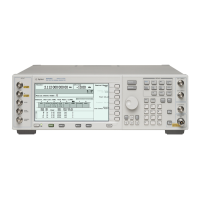422 Chapter 15
W-CDMA Digital Modulation for Component Test
W-CDMA Downlink Modulation
During waveform generation, the WCDMA and I/Q annunciators appear and the waveform is stored in
volatile ARB memory. The waveform is now modulating the RF carrier.
For instructions on storing this user-defined multicarrier W-CDMA state to the signal generator’s
non-volatile memory, see “Storing a Multicarrier W-CDMA State” on page 422.
Applying Modifications to an Active Multicarrier Waveform
1. Press
Multicarrier Define.
2. Move the cursor to row 2.
3. Press
Delete Row > Apply Multicarrier.
Notice that the waveform is regenerated to include the modification of the deleted row. Any changes made to
an active multicarrier waveform will not be applied until the
Apply Multicarrier softkey is pressed.
Configuring the RF Output
1. Set the RF output frequency to 2.17 GHz.
2. Set the output amplitude to −10 dBm.
3. Press
RF On/Off until On is highlighted.
The user-defined multicarrier W-CDMA signal is now available at the signal generator’s
RF OUTPUT connector.
Storing a Multicarrier W-CDMA State
This procedure teaches you how to store a multicarrier W-CDMA state to the signal generator’s non-volatile
memory.
If you have not created a multicarrier W-CDMA state, complete the steps in the previous section, “Creating
a User-Defined Multicarrier W-CDMA State” on page 419.
1. Press
Mode Setup to return to the top-level W-CDMA menu, where W-CDMA Off On is the first softkey.
2. Press
Multicarrier Define > Store Custom Multicarrier > Store To File.
If there is already a file name from the Catalog of MDWCDMA Files occupying the active entry area,
press the following keys:
Editing Keys > Clear Text.
3. Enter a file name (for example, 3CARRIER) using the alpha keys and the numeric keypad with a
maximum length of 23 characters.

